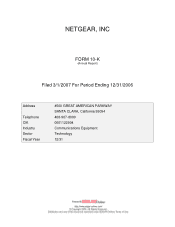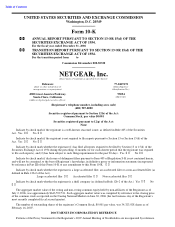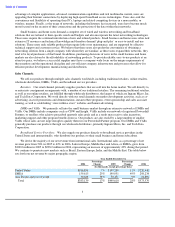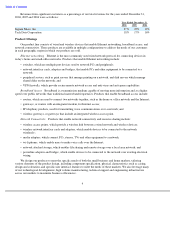Netgear 2006 Annual Report Download - page 10
Download and view the complete annual report
Please find page 10 of the 2006 Netgear annual report below. You can navigate through the pages in the report by either clicking on the pages listed below, or by using the keyword search tool below to find specific information within the annual report.
Table of Contents
We believe that the principal competitive factors in the small business and home markets for networking
products include product breadth, size and scope of the sales channel, brand name, timeliness of new product
introductions, product performance, features, functionality and reliability, price, ease-of-installation, maintenance
and use, and customer service and support.
To remain competitive, we believe we must invest significant resources in developing new products, enhancing
our current products, expanding our sales channels and maintaining customer satisfaction worldwide.
Research and Development
As of December 31, 2006, we had 62 employees engaged in research and development. We believe that our
success depends on our ability to develop products that meet the changing user needs and to anticipate and
proactively respond to evolving technology in a timely and cost-effective manner. Accordingly, we have made
investments in our research and development department in order to effectively evaluate new technologies and
develop and test new products. Our research and development employees work closely with our technology and
manufacturing partners to bring our products to market in a timely, high quality and cost-efficient manner.
We identify and qualify new technologies, and we work closely with our various technology suppliers and
manufacturing partners to develop products using one of the two manufacturing methodologies described below.
ODM. Under the original design manufacturer, or ODM, methodology, which we use for most of our product
development activities, we define the product concept and specification and perform the technology selection. We
then coordinate with our technology suppliers while they develop the chipsets, software and detailed circuit designs.
Once prototypes are completed, we work with our partners to complete the debugging and systems integration and
testing. Our ODMs are responsible for conducting all of the regulatory agency approval processes required for each
product. After completion of the final tests, agency approvals and product documentation, the product is released for
production.
OEM. Under the original equipment manufacturer, or OEM, methodology, which we use for a limited number
of products, we define the product specification and then purchase the product from OEM suppliers that have
existing products fitting our design requirements. Once a technology supplier’s product is selected, we work with the
OEM supplier to complete the cosmetic changes to fit into our mechanical and packaging design, as well as our
documentation and graphical user interface, or GUI, standard. The OEM supplier completes regulatory approvals on
our behalf. When all design verification and regulatory testing is completed, the product is released for production.
Our internal research and development efforts focus on improving the reliability, functionality, cost and
performance of our partner’s designs. In addition, we define the industrial design, GUI, documentation and
installation process of our products. In August 2006, we acquired SkipJam Corp. (“SkipJam”), a developer of
networkable media devices for integrating television into the home network and to the Internet for entertainment
content streaming. Our total research and development expenses were $18.4 million in 2006, $12.8 million in 2005
and $10.3 million in 2004.
Manufacturing
Our primary manufacturers are ASUSTek Computer, Inc., Cameo Communications Inc., Delta Networks
Incorporated, Gemtek Technology Co., Hon Hai Precision Industry Co., Ltd. (more commonly known as Foxconn
Corporation), and SerComm Corporation, all of which are headquartered in Taiwan. The actual manufacturing of our
products occurs primarily in mainland China, and is supplemented with manufacturing in Taiwan on a select basis.
We distribute our manufacturing among these key suppliers to avoid excessive concentration with a single supplier.
In addition to their responsibility for the manufacturing of our products, our manufacturers purchase all necessary
parts and materials to produce complete, finished goods. To maintain quality standards for our suppliers, we have
established our own product testing and quality organization based in Hong Kong and mainland China. They are
responsible for auditing and inspecting product quality on the premises of our ODMs and OEMs.
We currently outsource warehousing and distribution logistics to four third-party providers who are responsible
for warehousing, distribution logistics and order fulfillment. In addition, these parties are also responsible for
6























